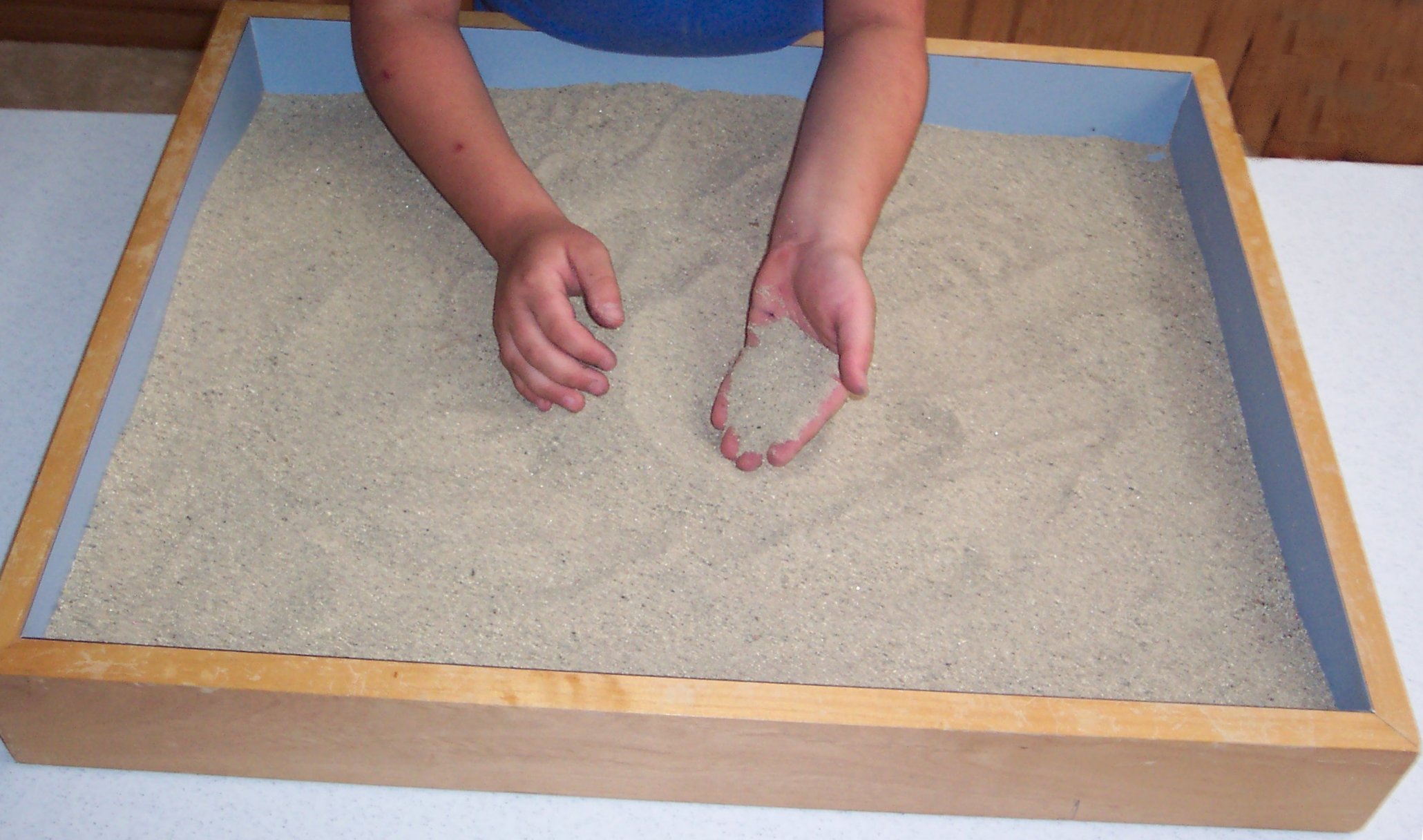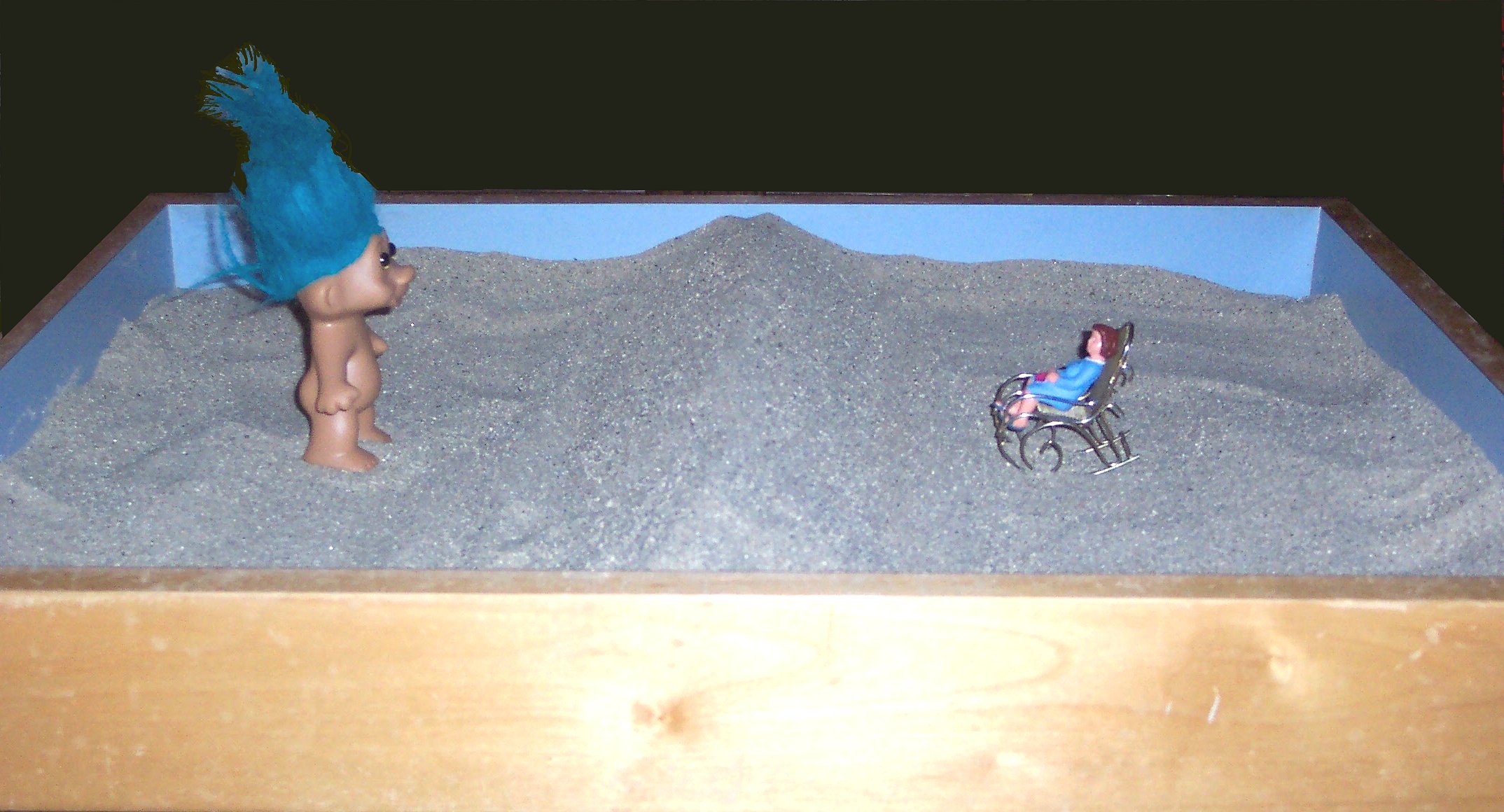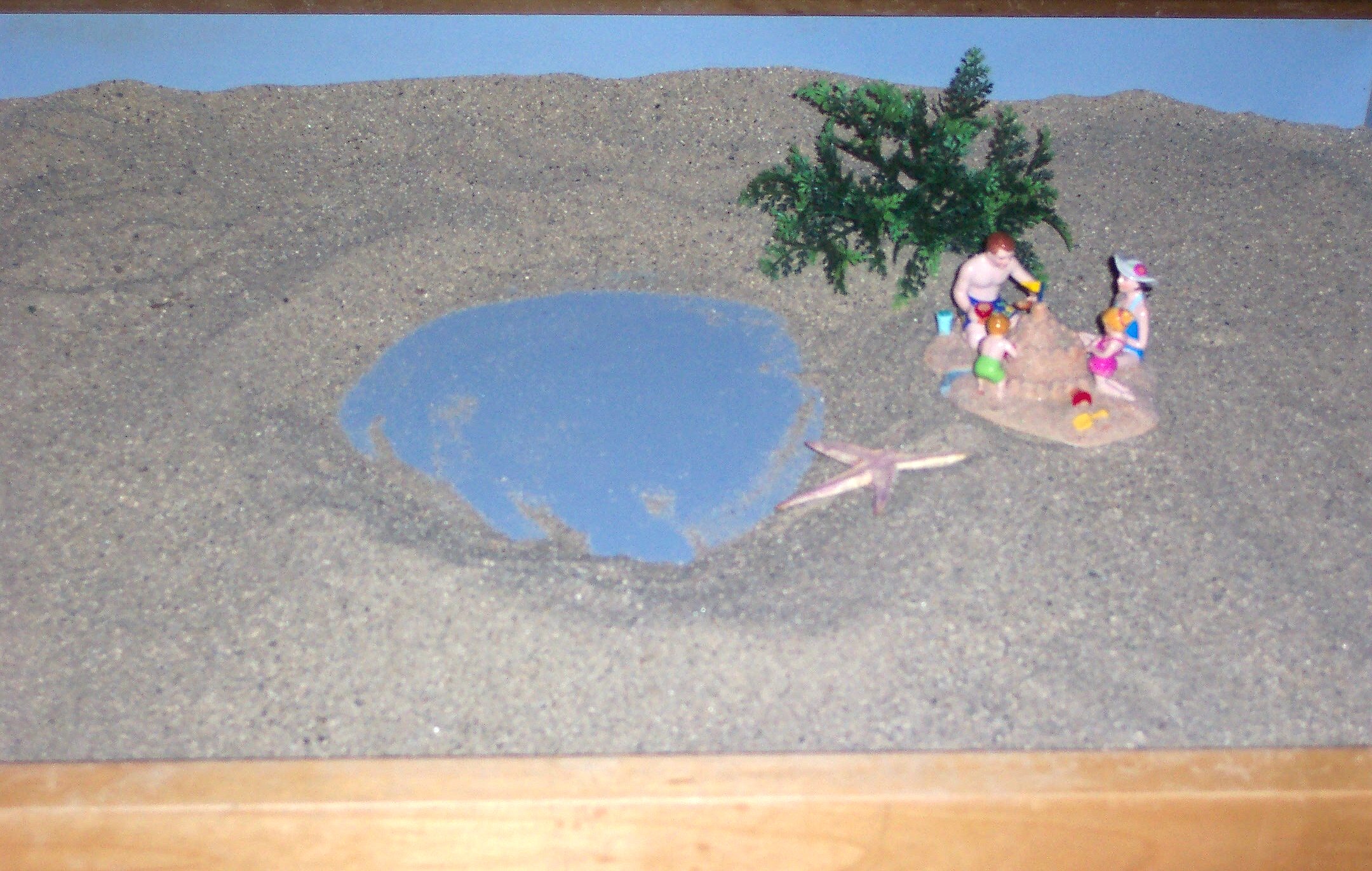To Access the Demonstration Course Quiz
This is a non-contact class – 1 hour credit
Be sure to submit the Evaluation Form after completing the quiz
Learning Objectives
- Describe how the dimension of play operates in Jungian Sandplay therapy.
- Discuss the Jungian sandplay therapy method of working in the sand in play therapy.
- Describe a fundamental understanding of how the Jungian Sandplay method creates the conditions for psychic healing and transformation through the free and protected space.
- Explain how the role of the therapist is critical to the Sandplay therapy process.
- Describe how the psyche moves simultaneously with the movement and changes in the symbolic content of the sandplay in play therapy.
- Discuss why no interpretation of the Sandplay is made to the client in the Jungian sandplay method.
About Jungian Sandplay Therapy ~
Course Lesson
Sandplay therapy is a psychotherapeutic tool, which has its roots in early twentieth century Europe. It is a method of play therapy that stems from the work of British physician, Margaret Lowenfeld (1939), who developed the ‘World Technique’ as a means of communicating non-verbally with children in treatment. The late Jungian therapist, Dora M. Kalff, of Switzerland developed what she termed, ‘Sandplay’ for use in Jungian therapy.
The Jungian Sandplay method facilitates the client’s ability to access the play dimension of consciousness, where all psychological healing and transformation occurs. Sandplay is used in treatment of both children and adults.
The Sandplay method consists of the psychotherapy client’s creation of a three-dimensional picture with miniature figures in a tray of sand in the protective presence of a trained practitioner. The work is generally done in silence. The therapist encourages the client to make whatever he or she likes in the sand tray and gives no further instructions. As the client works in the sand tray, the therapist sits nearby making note of what figures the client uses and what the client says, or does, if anything. The therapist makes no interpretation with the client.
The sand tray is 28 1/2 inches long by 19 1/2 inches wide and 3 inches deep. The sides and bottom of the inside of the sand tray are colored light blue. By moving the sand aside, the blue coloration can be used to represent areas of water in the sandy landscape. Real water can be added to the sand to make it adaptable to being shaped and sculpted. Dora Kalff designed the sand tray to focus the client’s attention and to facilitate the psychic change process.
Working Damp Sand
Miniature figures representing all aspects of life and fantasy are arranged on shelves near the sand tray. A wide variety of building materials out of which the client can fashion needed items is also available.
Sandplay Shelves and Figures

The actual completion of a sand tray is deceptively simple. It is the profound psychological process that underlies this simple creation of a picture in the sand that is the focus of training for Sandplay therapists.
The theoretical foundation of Sandplay therapy is based on the Carl Jung’s concept that the psyche has an autonomous disposition to heal itself and to grow toward fullness. Jung observed that when given the proper conditions, this natural tendency is activated.
The Jungian Sandplay therapy method creates the conditions necessary to activate the psyche’s natural healing processes. Dora Kalff referred to this as the free and protected space in sandplay. In order to heal and develop, the psyche must have complete freedom to do whatever it needs. This is the unrestricted dimension of play. At the same time, this freedom demands absolute safety.
The free and protected space is one of the primary features distinguishing Jungian sandplay from other methods of working in the sand tray. It is created by the quality of the Sandplay therapist’s presence. These subtle and non-quantifiable qualities of presence include the therapist’s inner stillness, the security of the therapeutic boundaries, the therapist’s ability to hold the tumult of psychic change undergone by the client during sandplay, and the therapist’s ability to understand what is transpiring in the Sandplay process. These and other factors work to establish the secure and trusting conditions the client’s psyche needs to move beyond its current limits and to access the resources of the central archetype of the Self.
The creation of a series of three-dimensional Sandplays facilitates healing and transformation by bringing up conflicts from the unconscious in the symbolic form of the miniature figures and the shapes in the sand. A healthy re-ordering of psychological contents takes place simultaneously with the client’s movements and changes of the three-dimensional symbolic images over the course of the Sandplay process. In other words, the elements of client’s psyche being worked on in the sandplay process are carried by the Sandplay images. The client’s psyche moves and re-orders to the Self, as those images shift and transform over the course of several Sandplays.
Psychic Movement in Symbolic Forms in Sandplay – Simulated Examples
The following simulated sand trays show psychic movement through the three-dimensional symbolic nature of sandplay. These are NOT actual sandplays, but illustrative examples only.*
Sample Tray A1
Sample Tray A2 (detail)
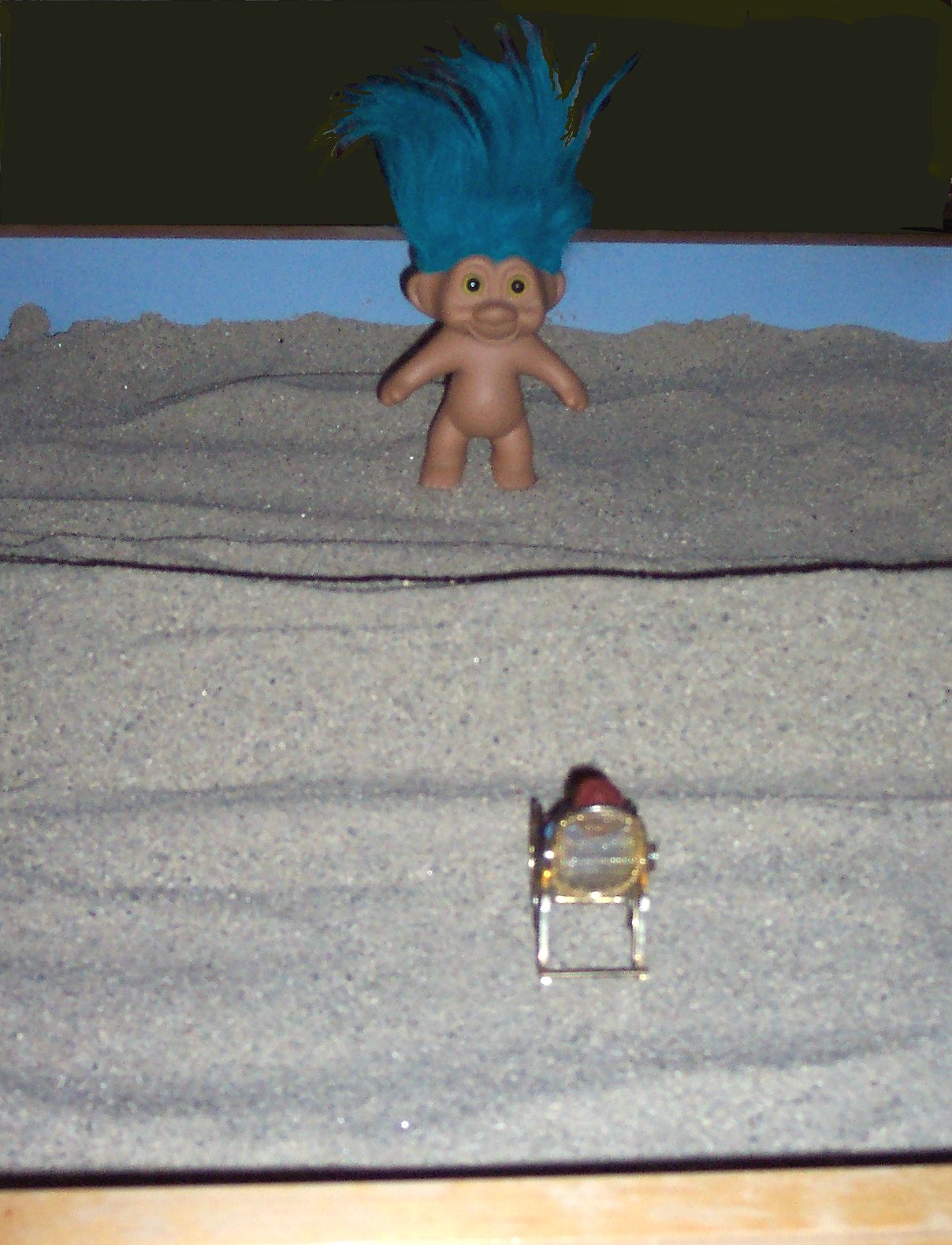
Sample Tray A3 (detail)
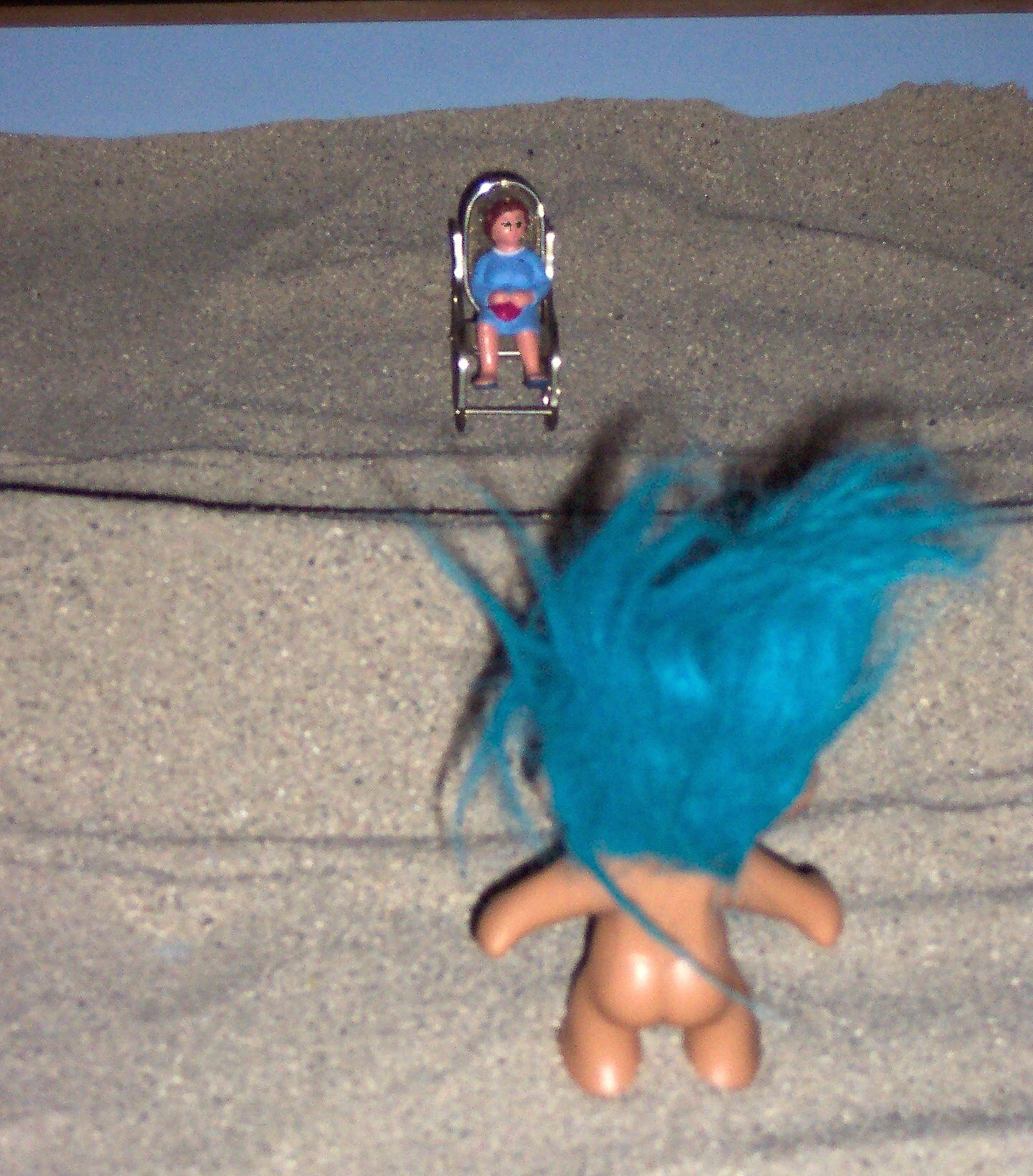
Tray A Discussion
In this first example, we see two symbolic qualities facing each other, across a large barrier. If these were aspects of the psyche in an actual sandplay process, we would likely observe two very different aspects of the client’s psyche beginning to confront, meet, fight, etc. Also, we would see that something substantial is held in the sandy barricade.
Sample Tray B1
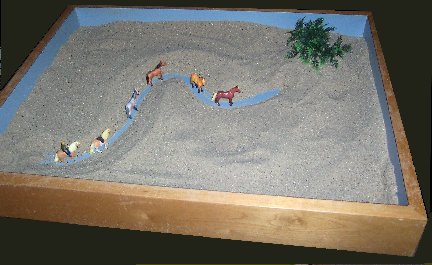 Sample Tray B2 (detail)
Sample Tray B2 (detail)

Tray B Discussion
Let us assume that later in the process we saw this line of animals moving toward a green hill. We might observe that the psyche’s formerly divided energies are flowing, or moving in greater harmony. (Naturally, as in any symbolic work, there are countless possibilities for understanding what might be transpiring in the sandplay, given conditions, presenting issues, and so on.) The important point is that the movement and content of the symbolic figures, literally carries the psyche in a new direction. As the figures move and change, the psyche moves and changes.
Tray C Discussion
Continuing to pretend, if we saw this family building a sand castle on the beach of a pond, or lake, later on in the same process, we might assume that the new movement of energies is coming together to build something cooperatively.
Conclusion
Through the transformative nature of what is known as the ‘transcendent function,’ the symbolic process of Sandplay involves a re-ordering of the conscious ego to the Self, considered the central archetype in Jungian psychology. The effectiveness of sandplay therapy is directly related to the therapist’s ability to properly understand the subtle, but powerful movements of the client’s psyche that take place in the symbolic content of the sandplay. Practicing Sandplay therapy requires extensive study and experience, and includes the therapist doing his or her ownSandplay work with an Association for Sandplay Therapy Registered Sandplay Therapist – STR.
An essential component of the free, play dimension of Jungian Sandplay is that no interpretation is made with the client at the time of the production of the sand tray. Nonetheless, the protected dimensions of sandplay demand that the therapist develops an understanding of what is transpiring in the client’s Sandplay process. The therapist’s understanding of the client’s Sandplay process plays a critical role in the ‘containment,’ or ‘holding’ of the client’s emerging unconscious material. While the psyche transforms at its deepest levels in the Sandplay work, the client does not develop a conscious understanding of this healing and transformation for some time. It takes time to integrate the changes in to consciousness. Thus, we can understand how a premature interpretation with the client would interfere with the integration of the work.
The Association for Sandplay Therapy – AST has designed a curriculum for training and registration as a Registered Sandplay Therapist – RST. Barbara A. Turner, PhD, the Facilitator of our Learning Center courses, is a Registered Sandplay Therapist – Consulting Teacher, and follows these training guidelines.
For Training Requirements for AST Registration Visit www.SandplayAssociation.com
*These are simulated examples for demonstration purposes only. Actual Sandplay case material is used for training purposes with the generous permission of the clients and under conditions of total anonymity. The Demonstration Class is available to all visitors. We do not use real sandplays in the Demonstration class, because it is vitally important to the process that people doing Sandplay have no conceptions of what is the ‘right’ way or ‘wrong’ way to do a sand tray. There are no rights or wrongs, and the Sandplay client must have total freedom to do whatever they need to in the sand. Actual sandplay case material is used in the readings and in the Intermediate and Advanced Courses.

